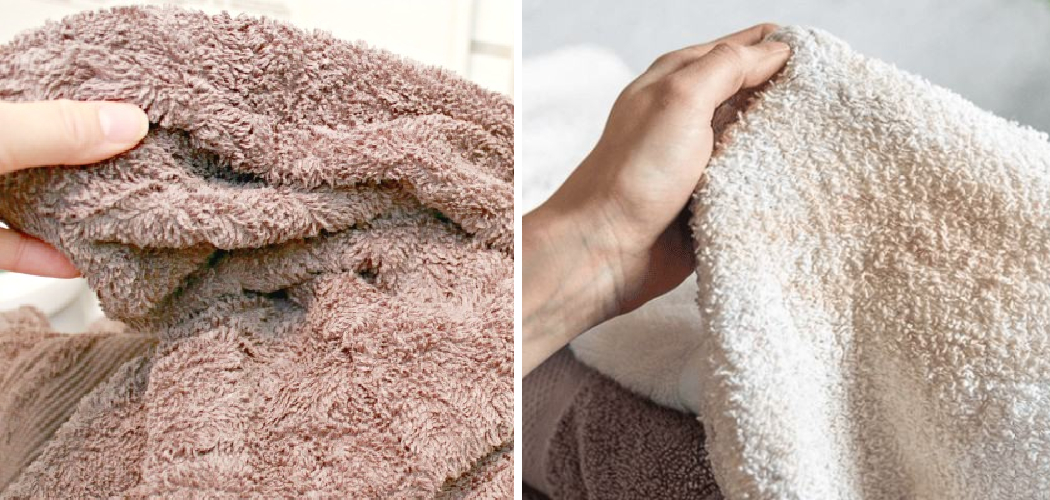Are you struggling with moldy towels that have a musty smell even after washing? Mold can easily grow on damp or wet fabrics, and towels are no exception. But don’t worry; there are simple steps you can take to remove mold from your towels and prevent it from coming back.
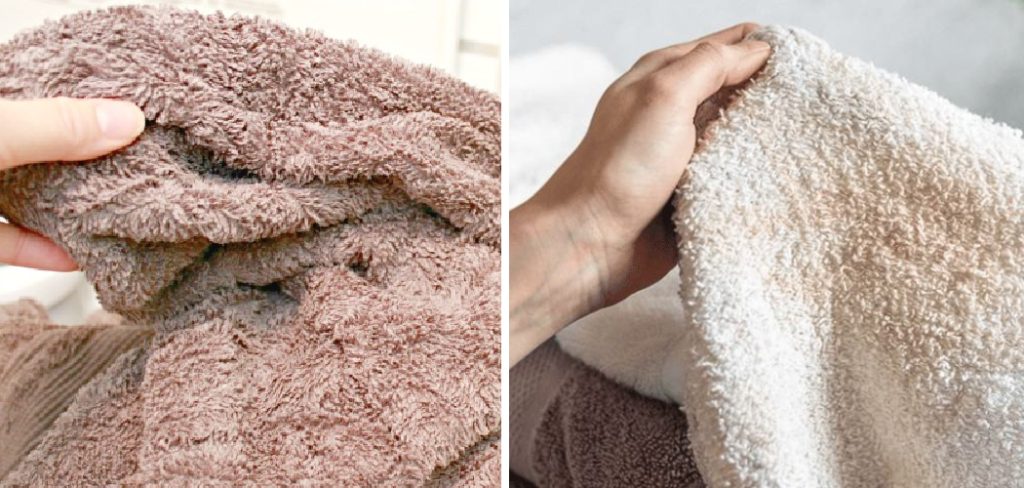
Discovering mold on your towels can be both unsettling and frustrating. The presence of mold ruins the aesthetic appeal of your towels and can pose health risks due to the potential for allergic reactions and respiratory problems. Fortunately, removing mold from towels is not as daunting a task as it might seem.
In this guide on how to remove mold from towels, we will explore effective strategies to eliminate mold, restore your towels’ freshness, and prevent future mold growth. By following a few simple steps, you can ensure your towels remain clean, hygienic, and pleasant to use.
What are the Benefits of Removing Mold From Towels?
Before we dive into the steps for removing mold from towels, let’s first understand why it is important to do so. Here are some benefits of keeping your towels mold-free:
- Maintains Hygiene: Mold growth on towels can harbor bacteria and germs that can spread onto your skin when using them. By removing mold, you eliminate potential health risks and maintain proper hygiene.
- Restores Freshness: Moldy towels can have a musty smell that is unpleasant and difficult to eliminate. By removing mold, you can restore the freshness of your towels and make them more pleasant to use.
- Prolongs Lifespan: Regular exposure to mold can weaken the fibers in your towels, making them thin and less absorbent. By removing mold, you can prolong the lifespan of your towels.
- Prevents Future Growth: Mold thrives in damp environments, so by regularly removing mold from your towels, you can prevent it from coming back and ensure your towels stay clean and fresh.
These are just a few reasons why removing mold from your towels is important. Now, let’s dive into the steps for effectively removing mold and keeping it at bay.
What Will You Need?
To remove mold from your towels, you will need the following materials:
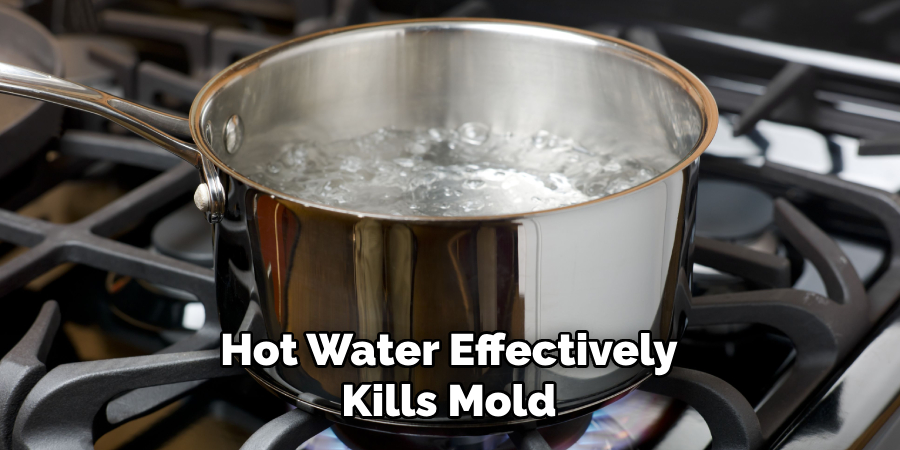
- Hot Water: Hot water effectively kills mold and bacteria on fabrics.
- White Vinegar: White vinegar has natural anti-fungal properties and is safe for most fabrics.
- Baking Soda: Baking soda helps to absorb moisture and eliminate odors from towels.
- Lemon Juice: Lemon juice has natural bleaching properties and can help remove stubborn stains caused by mold.
- Washing Machine or Basin: You will need a washing machine or basin to clean your towels in. If using a basin, ensure it is large enough for your towels to soak comfortably.
Once you have gathered these materials, you are ready to begin removing mold from your towels.
8 Easy Steps on How to Remove Mold From Towels:
Step 1: Pre-Soak Your Towels
The first step in removing mold from your towels is to pre-soak them. This process helps to loosen the mold spores, making it easier to remove them during the washing cycle. Follow these instructions for pre-soaking your towels:
- Fill a Basin or Tub With Hot Water: The water’s heat will help kill off some of the mold spores. Ensure the water is as hot as you can safely handle.
- Add White Vinegar: Pour one cup of white vinegar into the basin or tub. Vinegar is a powerful mold killer thanks to its acid content, and it’s safe for most fabrics.
- Submerge Your Towels: Place your moldy towels into the vinegar and water solution. Ensure the towels are completely submerged for maximum exposure to the vinegar solution.
- Allow to Soak: Leave your towels to soak in the solution for at least one hour. For severe mold infestations, consider soaking them overnight to give the vinegar ample time to work its magic.
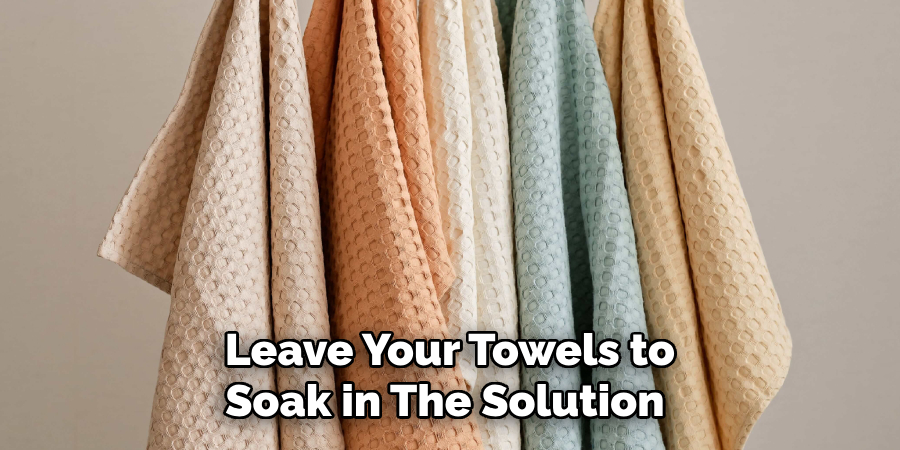
Pre-soaking your towels prepares them for a more thorough washing, ensuring that the mold is easier to remove. Once the towels have soaked for the appropriate amount of time, you are ready to move on to the next step in the mold removal process.
Step 2: Wash Your Towels with Hot Water and Detergent
After your towels have finished soaking, the next step is to wash them thoroughly using hot water and detergent. Here’s how to do it:
- Transfer Towels to Washing Machine: Carefully move your pre-soaked towels from the basin or tub to your washing machine. If you’ve soaked them in the machine, drain the soaking water.
- Add Detergent: Use your regular laundry detergent, but consider adding a bit more than you would for a typical load to ensure the towels get thoroughly cleaned.
- Set to Hot Water Cycle: Choose the hottest water setting on your washing machine that is safe for the towels’ fabric. Hot water is crucial for killing any remaining mold spores.
- Add Baking Soda: For extra cleaning power, add half a cup of baking soda to the wash. Baking soda helps remove odors and any lingering mildew or mold spores.
- Start the Washing Cycle: Run your washing machine on a regular cycle, ensuring a thorough rinse to remove all the vinegar, mold spores, and any detergent residue.
Washing your towels with hot water and detergent after soaking them in vinegar will help ensure that any remaining mold spores are killed and removed. Once the wash cycle is complete, your towels will be ready for the next step.
Step 3: Add a Lemon Juice Rinse
After the washing cycle with hot water and detergent, an additional step to ensure the complete removal of mold and to freshen up your towels further is to use a lemon juice rinse. Here’s how to incorporate this step:
- Prepare Lemon Juice Solution: Mix half a cup of lemon juice with one gallon of hot water. Lemons’ natural bleaching properties will help remove stubborn mold stains and lighten your towels without the use of harsh chemicals.
- Rinse Towels in Lemon Juice Solution: After the washing cycle, instead of immediately transferring your towels to the dryer, soak them in the lemon juice solution for about an hour. This will help remove any lingering mold stains and leave your towels with a fresh, citrus scent.
- Final Washing Cycle: After soaking in the lemon juice solution, wash your towels once more in the washing machine using hot water but no detergent. This final cycle will rinse out any remnants of lemon juice, vinegar, or baking soda, ensuring the towels are completely clean and fresh.

Incorporating a lemon juice rinse into the cleaning process not only aids in mold removal but also naturally brightens and deodorizes your towels, leaving them feeling and smelling pleasant.
Step 4: Dry Your Towels Thoroughly
The final step in ensuring your towels are free from mold is to dry them thoroughly. Moisture is the primary enabler of mold growth, so removing as much moisture as possible during the drying process is crucial. Here’s how to do it:
- Use High Heat Setting: Transfer your towels to the dryer and select the highest heat setting that is safe for the fabric. High heat helps kill any remaining mold spores.
- Dry Completely: Allow the towels to dry completely in the dryer. Check that they are fully dry to the touch before removing them. For thicker towels, more than one drying cycle may be required.
- Sun-Dry If Possible: If the weather permits, you can also dry your towels outside in direct sunlight. The sun’s UV rays are natural disinfectants and can help kill any surviving mold spores, in addition to giving your towels a fresh, natural scent.
- Check for Any Remaining Mold: Before storing your towels, inspect them carefully for any signs of remaining mold. If you detect any mold or the towels still smell musty, you may need to repeat the cleaning process.
You significantly reduce the risk of mold reappearing by thoroughly drying your towels and eliminating all moisture. Ensuring your towels are completely dry before storage is key to keeping them fresh, clean, and mold-free.
Step 5: Store Your Towels Properly
Proper storage is crucial to prevent mold and mildew from returning to your freshly cleaned towels. Here are tips for storing your towels to keep them dry and free from mold:

- Ensure Towels Are Completely Dry: Double-check that towels are completely dry before storing. Even a slight dampness can encourage mold growth.
- Use Well-Ventilated Cabinets or Closets: Store your towels in an area with good air circulation. Avoid cramped spaces where air cannot freely move around the towels, as this can create a humid environment conducive to mold.
- Leave Space Between Towels: When folding and putting away your towels, don’t overcrowd them. Leave some space between each towel to allow air to circulate, which helps keep them dry and fresh.
- Consider Adding Silica Gel Packets: For extra protection against moisture, you can place silica gel packets in the storage area. These packets absorb excess moisture and can help keep your closet or cabinet dry.
- Regularly Check for Freshness: Every so often, check your towels for any signs of mustiness or dampness. Regular inspections can help you catch any potential mold issues before they escalate.
By following these storage tips, you can help ensure that your towels remain fresh, dry, and mold-free for longer. Proper towel storage is the final step in maintaining the cleanliness and longevity of your bathroom essentials.
Step 6: Regular Maintenance and Prevention Tips
To keep your towels in pristine condition and prevent the recurrence of mold, it’s essential to adopt a routine of regular maintenance and preventive measures. Here are some practical tips to keep your towels fresh and mold-free:
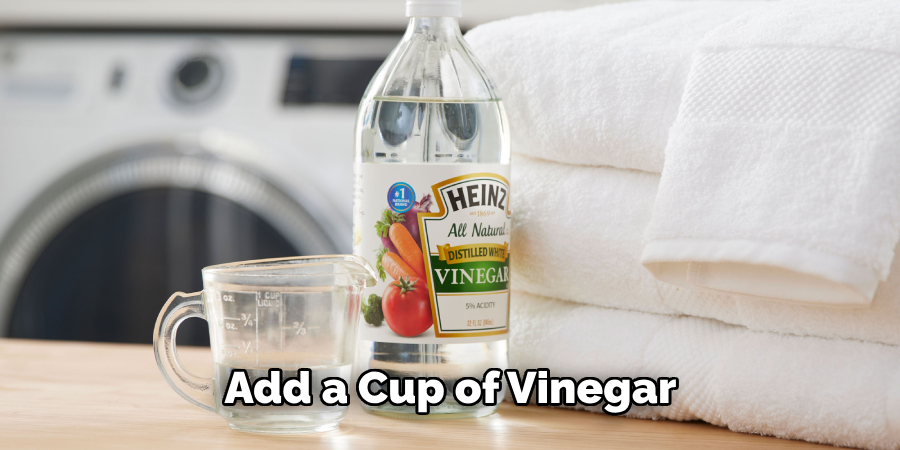
- Wash Towels Regularly: Don’t wait for towels to visibly soil or smell before washing. Regular laundering, ideally after every 3-4 uses, prevents the buildup of moisture and bacteria that can lead to mold.
- Use Vinegar or Baking Soda Occasionally: Add a cup of vinegar or baking soda to your towel wash once a month. This monthly treatment helps break down any buildup and maintains the fluffiness and absorbency of your towels.
- Avoid Leaving Towels Damp: After using your towels, make sure to hang them out in an area with good air circulation. If a towel is left in a heap or hung without the ability to dry properly, it becomes a breeding ground for mold and mildew.
- Keep the Bathroom Well-Ventilated: Ensure your bathroom is well-ventilated during and after showers. Use an exhaust fan or open a window to help moisture escape, reducing the overall humidity in the room.
- Rotate Your Towels: Having multiple sets of towels and rotating their use allows each set to fully dry and breathe between uses. This rotation system also reduces wear and tear, extending the life of your towels.
Implementing these straightforward maintenance and prevention strategies ensures that your towels remain hygienic, soft, and free from mold and mildew, contributing to a healthier and more pleasant bathroom environment.
Step 7: Addressing Persistent Mold Issues
If you still encounter persistent mold issues after following the steps outlined for cleaning, drying, and storing your towels, consider more in-depth solutions. Persistent mold could indicate deeper problems, such as plumbing leaks, high indoor humidity, or insufficient ventilation in laundry or bathroom areas. Here’s what you can do:

- Investigate for Leaks: Check your home for any plumbing leaks or water intrusion that could increase humidity levels and contribute to mold growth.
- Use a Dehumidifier: In areas prone to high humidity, consider using a dehumidifier to help control the moisture level in the air, making it less conducive for mold to grow.
- Improve Ventilation: Enhance air circulation and ventilation in your home, especially in bathrooms and laundry areas. This can be achieved by installing exhaust fans or opening windows to allow for air exchange.
- Seek Professional Help: If mold persists, it might be beneficial to consult with a mold remediation professional who can identify hidden sources of mold and recommend a comprehensive solution.
By addressing any underlying issues that contribute to persistent mold growth, you will not only protect your towels but also improve the overall air quality and healthiness of your home environment.
Step 8: Final Check and Routine Review
Once you have addressed any persistent mold issues and implemented the steps for cleaning, drying, and storing your towels, it’s beneficial to establish a routine review. This review involves periodically checking your towels and storage areas to ensure that your preventive measures are effective. Here’s how to conduct a final check and maintain it as part of your routine:

- Inspect Towels Regularly: Every few weeks, take time to inspect your towels for any signs of mold or mustiness. This regular inspection helps you catch and address any issues early, before they become problematic.
- Evaluate Storage Conditions: Review the condition of your storage area to ensure it remains well-ventilated and free from excess moisture. Make adjustments as necessary to maintain an optimal environment for your towels.
- Refresh Your Towels: Even with the best care, towels can eventually wear out and start retaining moisture more easily, which can lead to mold. If you notice your towels are no longer as absorbent or fresh as they used to be, consider refreshing your collection.
- Stay Informed: Keep up-to-date with any new tips or products that can help in the fight against mold in your household textiles. Implementing innovative solutions can enhance your preventive measures.
By conducting a final check and incorporating these steps into a regular maintenance routine, you ensure the longevity and freshness of your towels.
With proper cleaning, drying, storage, and maintenance, your towels can remain in excellent condition for years to come.
5 Things You Should Avoid
When tackling mold on towels, certain practices can actually worsen the problem or damage your towels. Here are five things you should avoid:
- Avoid Using Bleach on Colored Towels: While bleach is effective in killing mold and bacteria, it can also damage the fibers of colored towels and cause fading. Use color-safe alternatives instead.
- Don’t Leave Wet Towels in the Washer: Allowing towels to sit in the washer after the cycle has finished can encourage mold and mildew growth. Transfer towels to the dryer or hang them up to dry immediately after washing.
- Avoid Overloading the Washing Machine: Overloading prevents towels from moving freely, which can result in them not being cleaned properly. This also hinders the thorough removal of mold spores and can lead to a musty smell.
- Don’t Use Too Much Detergent: Excessive detergent can leave a residue on towels, which not only hampers their absorbency but can also provide a breeding ground for mold. Use the recommended amount of detergent for your load size.
- Avoid Storing Towels in Damp Spaces: Storing clean towels in a damp bathroom or poorly ventilated cupboard can undo all your hard work. Ensure your storage area is dry and receives adequate airflow to prevent mold from taking hold again.
By avoiding these common pitfalls, you can more effectively combat mold growth on your towels and maintain their freshness and longevity.
Conclusion
How to remove mold from towels requires a combination of thorough cleaning, proper drying, attentive storage, and regular maintenance. By adopting a proactive approach to towel care, you can significantly reduce the likelihood of mold growth and ensure that your towels remain fresh, clean, and hygienic.
The steps outlined in this guide, from initial detection and cleaning to preventive measures and routine reviews, offer a comprehensive strategy for effectively combating mold. Additionally, being mindful of common pitfalls and adopting best practices for towel maintenance will further safeguard against mold recurrence.
Remember, the key to mold-free towels lies in consistent care and prompt action at the first sign of mold. With these guidelines, you can enjoy the comfort and cleanliness of your towels for many years to come.

